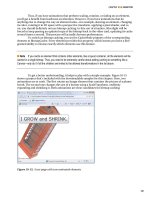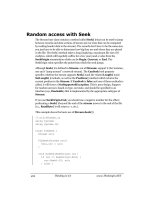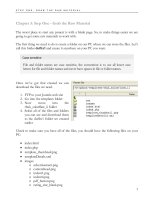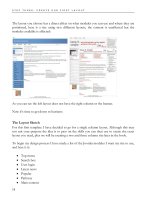A Laboratory Course in C++Data Structures phần 7 pptx
Bạn đang xem bản rút gọn của tài liệu. Xem và tải ngay bản đầy đủ của tài liệu tại đây (477.15 KB, 43 trang )
Laboratory 11: Prelab Exercise
Binary Search Tree ADT | 241
Name __________________________________________ Date _______________________
Section _________________________________________
Step 1: Implement the operations in Binary Search Tree ADT using a linked tree structure. As
with the linear linked structures you developed in prior laboratories, your implementation
of the linked tree structure uses a pair of classes: one for the nodes in the tree
(BSTreeNode) and one for the overall tree structure (BSTree). Each node in the tree
should contain a data item (dataItem) and a pair of pointers to the node’s children
(left and right). Your implementation should also maintain a pointer to the tree’s root
node (root). Base your implementation on the following declarations from the file
bstree.hs. An implementation of the showStructure operation is given in the file
show11.cpp.
template < class DT, class KF >
class BSTreeNode // Facilitator for the BSTree class
{
private:
// Constructor
BSTreeNode ( const DT &nodeDataItem,
BSTreeNode *leftPtr, BSTreeNode *rightPtr );
// Data members
DT dataItem; // Binary search tree data item
BSTreeNode *left, // Pointer to the left child
*right; // Pointer to the right child
friend class BSTree<DT,KF>;
};
template < class DT, class KF > // DT : tree data item
class BSTree // KF : key field
{
public:
// Constructor
BSTree ();
// Destructor
~BSTree ();
// Binary search tree manipulation operations
void insert ( const DT &newDataItem ) // Insert data item
throw ( bad_alloc );
bool retrieve ( KF searchKey, DT &searchDataItem ) const;
// Retrieve data item
bool remove ( KF deleteKey ); // Remove data item
void writeKeys () const; // Output keys
void clear (); // Clear tree
// Binary search tree status operations
bool isEmpty () const; // Tree is empty
bool isFull () const; // Tree is full
// Output the tree structure used in testing/debugging
void showStructure () const;
private:
// Recursive partners of the public member functions insert
// prototypes of these functions here.
void showSub ( BSTreeNode<DT,KF> *p, int level ) const;
// Data member
BSTreeNode<DT,KF> *root; // Pointer to the root node
};
Step 2: The declaration of the BSTree class in the file bstree.hs does not include
prototypes for the recursive private member functions needed by your
implementation of the Binary Search Tree ADT. Add these prototypes and
save the resulting class declarations in the file bstree.h.
Step 3: Save your implementation of the Binary Search Tree ADT in the file
bstree.cpp. Be sure to document your code.
242 | Laboratory 11
Laboratory 11: Bridge Exercise
Binary Search Tree ADT | 243
Name __________________________________________ Date _______________________
Section _________________________________________
Check with your instructor whether you are to complete this exercise prior to your lab period
or during lab.
The test program in the file test11.cpp allows you to interactively test your implementation of
the Binary Search Tree ADT using the following commands.
Command Action
+key Insert (or update) the data item with the specified key.
?key Retrieve the data item with the specified key and output it.
-key Delete the data item with the specified key.
K Output the keys in ascending order.
E Report whether the tree is empty.
F Report whether the tree is full.
C Clear the tree.
Q Quit the test program.
Step 1: Prepare a test plan for your implementation of the Binary Search Tree ADT. Your test
plan should cover trees of various shapes and sizes, including empty, single branch, and
single data item trees. A test plan form follows.
Step 2: Execute your test plan. If you discover mistakes in your implementation, correct them
and execute your test plan again.
Test Plan for the Operations in the Binary Search Tree ADT
Test Case Commands Expected Result Checked
Laboratory 11: In-lab Exercise 1
244 | Laboratory 11
Name __________________________________________ Date _______________________
Section _________________________________________
A database is a collection of related pieces of information that is organized for easy retrieval. The
following set of accounts records, for instance, form an accounts database.
Record # Account ID First name Last name Balance
0 6274 James Johnson 415.56
1 2843 Marcus Wilson 9217.23
2 4892 Maureen Albright 51462.56
3 8337 Debra Douglas 27.26
4 9523 Bruce Gold 719.32
5 3165 John Carlson 1496.24
Each record in the accounts database is assigned a record number based on that record’s
relative position within the database file. You can use a record number to retrieve an account
record directly, much as you can use an array index to reference an array data item directly. The
following program from the file getdbrec.cpp, for example, retrieves a record from the accounts
database in the file accounts.dat.
#include <iostream>
#include <fstream>
using namespace std;
//
//
// Declarations specifying the accounts database
//
const int nameLength = 11; // Maximum number of characters in
// a name
const long bytesPerRecord = 38; // Number of bytes used to store
// each record in the accounts
// database file
struct AccountRecord
{
int acctID; // Account identifier
char firstName[nameLength], // Name of account holder
lastName[nameLength];
double balance; // Account balance
};
void main ()
{
ifstream acctFile (“accounts.dat”); // Accounts database file
AccountRecord acctRec; // Account record
long recNum; // User input record number
// Get the record number to retrieve.
cout << endl << “Enter record number: “;
cin >> recNum;
// Move to the corresponding record in the database file using the
// seekg() function.
acctFile.seekg(recNum*bytesPerRecord);
// Read in the record.
acctFile >> acctRec.acctID >> acctRec.firstName
>> acctRec.lastName >> acctRec.balance;
// Display the record.
cout << recNum << “ : “ << acctRec.acctID << “ ”
<< acctRec.firstName << “ “ << acctRec.lastName << “ ”
<< acctRec.balance << endl;
}
Record numbers are assigned by the database file mechanism and are not part of
the account information. As a result, they are not meaningful to database users. These
users require a different record retrieval mechanism, one that is based on an account
ID (the key for the database) rather than a record number.
Retrievals based on account ID require an index that associates each account ID
with the corresponding record number. You can implement this index using a binary
search tree in which each data item contains two fields: an account ID (the key) and a
record number.
struct IndexEntry
{
int acctID; // (Key) Account identifier
long recNum; // Record number
int getKey () const
{ return acctID; } // Return key field
};
BSTree<IndexEntry,int> index; // Database index
You build the index by reading through the database account by account,
inserting successive (account ID, record number) pairs into the tree as you progress
through the file. The following index tree, for instance, was produced by inserting the
account records shown above into an (initially) empty tree.
Binary Search Tree ADT | 245
Given an account ID, retrieval of the corresponding account record is a two-step
process. First, you retrieve the data item from the index tree that has the specified
account ID. Then, using the record number stored in the index data item, you read the
corresponding account record from the database file. The result is an efficient retrieval
process that is based on account ID.
Step 1: Using the program shell given in the file database.cs as a basis, create a
program that builds an index tree for the accounts database in the file
accounts.dat. Once the index is built, your program should
• Output the account IDs in ascending order
• Read an account ID from the keyboard and output the corresponding
account record
Step 2: Test your program using the accounts database in the text file accounts.dat. A
copy of this database in given below. Try to retrieve several account IDs,
including account IDs that do not occur in the database. A test plan form
follows.
Record # Account ID First name Last name Balance
0 6274 James Johnson 415.56
1 2843 Marcus Wilson 9217.23
2 4892 Maureen Albright 51462.56
3 8337 Debra Douglas 27.26
4 9523 Bruce Gold 719.32
5 3165 John Carlson 1496.24
6 1892 Mary Smith 918.26
7 3924 Simon Becker 386.85
8 6023 John Edgar 9.65
9 5290 George Truman 16110.68
10 8529 Ellen Fairchild 86.77
11 1144 Donald Williams 4114.26
1892
4
4892
2
9523
5
6274
0
2843
1
8837
3
246 | Laboratory 11
Test Plan for the Accounts Database Indexing Program
Test Case Expected Result Checked
Binary Search Tree ADT | 247
Laboratory 11: In-lab Exercise 1
248 | Laboratory 11
Name __________________________________________ Date _______________________
Section _________________________________________
Binary search trees containing the same data items can vary widely in shape depending on the
order in which the data items were inserted into the trees. One measurement of a tree’s shape is its
height—that is, the number of nodes on the longest path from the root node to any leaf node. This
statistic is significant because the amount of time that it can take to search for a data item in a
binary search tree is a function of the height of the tree.
int getHeight () const;
Requirements:
None
Results:
Returns the height of a binary search tree.
You can compute the height of a binary search tree using a postorder traversal and the
following recursive definition of height:
Step 1: Implement this operation and add it to the file bstree.cpp. A prototype for this operation
is included in the declaration of the BSTree class in the file bstree.h.
Step 2: Activate the ‘
H’ (height) command in the test program in the file test11.cpp by removing
the comment delimiter (and the character ‘H’) from the lines that begin with “//H”.
Step 3: Prepare a test plan for this operation that covers trees of various shapes and sizes,
including empty and single-branch trees. A test plan form follows.
Step 4: Execute your test plan. If you discover mistakes in your implementation of the height
operation, correct them and execute your test plan again.
height
if base case
height height if recursive step
p
p ( )
max( (p left), (p right)) p ( )
()
=
=
→→+≠
00
10
Test Plan for the getHeight Operation
Test Case Commands Expected Result Checked
Binary Search Tree ADT | 249
Laboratory 11: In-lab Exercise 1
250 | Laboratory 11
Name __________________________________________ Date _______________________
Section _________________________________________
You have created operations that retrieve a single data item from a binary search tree and output
all the keys in a tree. The following operation outputs only those keys that are less than a specified
key.
void writeLessThan ( KF searchKey ) const
Requirements:
None
Results:
Outputs the keys in a binary search tree that are less than searchKey. The keys are output in
ascending order. Note that searchKey need not be a key in the tree.
You could implement this operation using an inorder traversal of the entire tree in which you
compare each key with searchKey and output those that are less than searchKey. Although
successful, this approach is inefficient. It searches subtrees that you know cannot possibly contain
keys that are less than searchKey.
Suppose you are given a searchKey value of 37 and the following binary search tree:
Because the root node contains the key 43, you can determine immediately that you do not need
to search the root node’s right subtree for keys that are less than 37. Similarly, if the value of
searchKey were 67, then you would need to search the root node’s right subtree but would not
need to search the right subtree of the node whose key is 72. Your implementation of the
writeLessThan operation should use this idea to limit the portion of the tree that must be
searched.
Step 1: Implement this operation and add it to the file bstree.cpp. A prototype for this operation
is included in the declaration of the BSTree class in the file bstree.h.
Step 2: Activate the ‘
<’ (less than) command in the test program in the file test11.cpp by
removing the comment delimiter (and the character ‘<’) from the lines that begin with
“//<”.
43
20
16 31
65 86
72
Step 3: Prepare a test plan for this operation that includes a variety of trees and
values for searchKey, including values of searchKey that do not occur in a
particular tree. Be sure to include test cases that limit searches to the left
subtree of the root node, the left subtree and part of the right subtree of the
root node, the leftmost branch in the tree, and the entire tree. A test plan
form follows.
Step 4: Execute your test plan. If you discover mistakes in your implementation of
the writeLessThan operation, correct them and execute your test plan
again.
Test Plan for the writeLessThan Operation
Test Case Commands Expected Result Checked
Binary Search Tree ADT | 251
Binary Search Tree ADT | 253
Name __________________________________________ Date _______________________
Section _________________________________________
What are the heights of the shortest and tallest binary search trees that can be constructed from a
set of N distinct keys? Give examples that illustrate your answer.
Binary Search Tree ADT | 255
Name __________________________________________ Date _______________________
Section _________________________________________
Given the shortest possible binary search tree containing N distinct keys, develop worst-case,
order-of-magnitude estimates of the execution time of the following Binary Search Tree ADT
operations. Briefly explain your reasoning behind each of your estimates.
retrieve O( )
Explanation:
insert O( )
Explanation:
remove O( )
Explanation:
writeKeys O( )
Explanation:
256 | Laboratory 11
In this laboratory you will:
Create an implementation of the Expression Tree ADT
using a linked tree structure
Develop an implementation of the Logic Expression
Tree ADT and use your implementation to model a
simple logic circuit
Create an expression tree copy constructor
Analyze how preorder, inorder, and postorder tree
traversals are used in your implementation of the
Expression Tree ADT
Expression Tree ADT
Objectives
Overview
Although you ordinarily write arithmetic expressions in linear form, you treat them as
hierarchical entities when you evaluate them. When evaluating the following
arithmetic expression, for example,
(1+3)*(6-4)
you first add 1 and 3, then you subtract 4 from 6. Finally, you multiply these
intermediate results together to produce the value of the expression. In performing
these calculations, you have implicitly formed a hierarchy in which the multiply
operator is built on a foundation consisting of the addition and subtraction operators.
You can represent this hierarchy explicitly using the following binary tree. Trees such
as this one are referred to as expression trees.
Expression Tree ADT
Data Items
Each node in an expression tree contains either an arithmetic operator or a numeric
value.
Structure
The nodes form a tree in which each node containing an arithmetic operator has a pair
of children. Each child is the root node of a subtree that represents one of the
operator’s operands. Nodes containing numeric values have no children.
Operations
ExprTree ()
Requirements:
None
Results:
Constructor. Creates an empty expression tree.
–
4631
*
+
258 | Laboratory 12
~ExprTree ()
Requirements:
None
Results:
Destructor. Deallocates (frees) the memory used to store an expression tree.
void build () throw ( bad_alloc )
Requirements:
None
Results:
Reads an arithmetic expression in prefix form from the keyboard and builds the
corresponding expression tree.
void expression () const
Requirements:
None
Results:
Outputs the corresponding arithmetic expression in fully parenthesized infix form.
float evaluate () const throw ( logic_error )
Requirements:
Expression tree is not empty.
Results:
Returns the value of the corresponding arithmetic expression.
void clear ()
Requirements:
None
Results:
Removes all the data items in an expression tree.
void showStructure () const
Requirements:
None
Results:
Outputs an expression tree with its branches oriented from left (root) to right (leaves)—
that is, the tree is output rotated counterclockwise 90 degrees from its conventional
orientation. If the tree is empty, outputs “Empty tree”. Note that this operation is
intended for testing/debugging purposes only. It assumes that arithmetic expressions
contain only single-digit, nonnegative integers and the arithmetic operators for
addition, subtraction, multiplication, and division.
Expression Tree ADT | 259
We commonly write arithmetic expressions in infix form—that is, with each operator
placed between its operands, as in the following expression:
( 1 + 3 ) * ( 6 — 4 )
In this laboratory, you construct an expression tree from the prefix form of an
arithmetic expression. In prefix form, each operator is placed immediately before its
operands. The expression above is written in prefix form as
* + 1 3 — 6 4
When processing the prefix form of an arithmetic expression from left to right,
you will, by definition, encounter each operator followed by its operands. If you know
in advance the number of operands an operator has, you can use the following
recursive process to construct the corresponding expression tree.
Read the next arithmetic operator or numeric value.
Create a node containing the operator or numeric value.
if the node contains an operator
then Recursively build the subtrees that correspond to the
operator’s operands.
else The node is a leaf node.
If you apply this process to the arithmetic expression
* + 1 3 — 6 4
then construction of the corresponding expression tree proceeds as follows:
260 | Laboratory 12
Note that in processing this arithmetic expression we have assumed that all
numeric values are single-digit, nonnegative integers, and thus, that all numeric values
can be represented as a single character. If we were to generalize this process to
include multidigit numbers, we would have to include delimiters in the expression to
separate numbers.
4
6
–
*
3
1
*
+
*
+
1
*
+
3
1
*
+
–
3
1
*
+
6
–
3
1
*
+
Read '*' Read '+'
Read '1' Read '3'
Read '–' Read '6'
Read '4'
Expression Tree ADT | 261
Assigned: Check or
list exercise numbers Completed
Laboratory 12: Cover Sheet
Expression Tree ADT | 263
Name __________________________________________ Date _______________________
Section _________________________________________
Place a check mark in the Assigned column next to the exercises your instructor has assigned to
you. Attach this cover sheet to the front of the packet of materials you submit following the
laboratory.
Prelab Exercise
Bridge Exercise
In-lab Exercise 1
In-lab Exercise 2
In-lab Exercise 3
Postlab Exercise 1
Postlab Exercise 2
Total
Expression Tree ADT | 265
Name __________________________________________ Date _______________________
Section _________________________________________
In the Overview you saw how the construction of an expression tree can be described using
recursion. In this exercise you will use recursive functions to implement the operations in the
Expression Tree ADT.
Step 1: Implement the operations in Expression Tree ADT using a linked tree structure. Assume
that an arithmetic expression consists of single-digit, nonnegative integers (‘
0’ ‘9’) and
the four basic arithmetic operators (‘
+’, ‘–’, ‘*’, and ‘/’). Further assume that each
arithmetic expression is input in prefix form from the keyboard with all of the characters
on one line.
As with the linear linked structures you developed in prior laboratories, your
implementation of the linked tree structure uses a pair of classes: one for the nodes in the
tree (ExprTreeNode) and one for the overall tree structure (ExprTree). Each node in the
tree should contain a character (dataItem) and a pair of pointers to the node’s children
(left and right). Your implementation also should maintain a pointer to the tree’s root
node (root). Base your implementation on the following declarations from the file
exprtree.hs. An implementation of the showStructure operation is given in the file
show12.cpp.
class ExprTree; // Forward declaration of the ExprTree class
class ExprTreeNode // Facilitator class for the ExprTree class
{
private:
// Constructor
ExprTreeNode ( char elem,
ExprTreeNode *leftPtr, ExprTreeNode *rightPtr );
// Data members
char dataItem; // Expression tree data item
ExprTreeNode *left, // Pointer to the left child
*right; // Pointer to the right child
friend class ExprTree;
};









